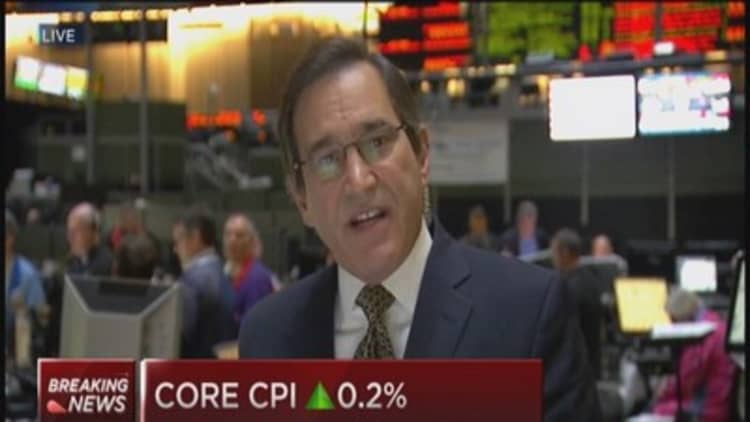
Initial claims for state unemployment benefits fell more than expected in the most recent week, while a reading on consumer prices came in unexpectedly flat in October.
The number of Americans filing new claims for unemployment benefits fell less than expected last week, but continued to point to strengthening labor market conditions.
Initial claims for state unemployment benefits slipped 2,000 to a seasonally adjusted 291,000 for the week ended Nov. 15, the Labor Department said on Thursday.
Read MoreIsthat all ya' got? Black Friday skepticism rising
The prior week's data was revised to show 3,000 more applications received than previously reported.
The four-week moving average of claims, considered a better measure of labor market trends as it irons out week-to-week volatility, increased 1,750 to 287,500, still at levels consistent with solid employment growth.
Economists polled by Reuters had forecast claims dipping to 285,000 last week. Claims have now been below the 300,000 threshold for 10 straight weeks, a sign that the labor market is tightening.
A Labor Department analyst said there were no special factors influencing last week's claims data, which covered the period during which the government surveyed employers for November's nonfarm payrolls.
Though the four-week average of claims increased 6,250 between the October and November survey period, another month of employment gains above 200,000 is expected.
The claims report showed the number of people still receiving benefits after an initial week of aid declined 73,000 to 2.33 million in the week ended Nov. 8, the lowest since December 2000.
The unemployment rate for people receiving jobless benefits was at 1.8 percent for a 10th straight week.
Underlying inflation picking up
The Labor Department said on Thursday falling gasoline prices, which offset rising shelter and medical costs, had restrained its Consumer Price Index last month.
The CPI had gained 0.1 percent in September and economists polled by Reuters had it slipping 0.1 percent last month. The CPI increased 1.7 percent in the 12 months through October, advanced by the same margin for a third straight month.
Read MoreSurpriseholiday hit: The ultra high-def 4K TV
Stripping out food and energy prices, the so-called core CPI rose 0.2 percent last month after nudging up 0.1 percent in September. In the 12 months through October, the core CPI rose 1.8 percent after rising 1.7 percent in September.
The Federal Reserve targets 2 percent inflation and it tracks an index that is running even lower than the CPI.
Declining energy and commodity prices against the backdrop of a slowing global economy, and a strengthening dollar are keeping inflation below the U.S. central bank's target.
Minutes of the Fed's Oct. 28-29 meeting published on Wednesday showed most policymakers expect inflation will edge lower in the near-term and subsequently move toward its target.
But there was a bit of concern over falling market-based inflation expectations, with some officials saying they should be monitored for signs of "a possible downward shift in longer-term inflation expectations."
The U.S. central bank has kept its short-term interest rate near zero since December 2008. Most economists expect the first interest rate increase sometime in the mid-2015.
In October, energy prices fell for a fourth straight month, with gasoline prices declining 3.0 percent after dropping 1.0 percent in September. Food prices edged up 0.1 percent after gaining 0.3 percent in September.
Within the core CPI, shelter costs increased 0.2 percent last month after increasing 0.3 percent in September.
The shelter index was up 3.0 percent in the 12 months through October.
Read MoreHavea home or baby webcam? Change the password now!
There were increases in airline fares and new motor vehicle prices as well as prices for prescription medication and hospital fees.
Tobacco prices also rose last month as did household furnishings, which posted their largest gain since November 2012.

